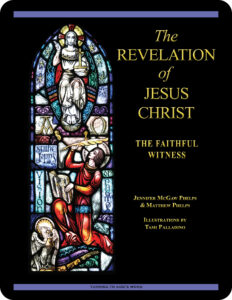 The Revelation of Jesus Christ:
The Revelation of Jesus Christ:
The Faithful Witness
Lesson 18 Mother of Harlots
the book of Revelation 17:1–18
Revised Standard Version Catholic Edition (RSVCE)*
New American Bible Revised Edition (NABRE)*
Catechism of the Catholic Church
Rosarium Virginis Mariae (Rosary of the Virgin Mary)
ex libris (in our library)
glossary for the book of Revelation
cross references in the book of Revelation
chapter-by-chapter review page
next lesson: Fallen, Fallen Is Babylon the Great!
This material coordinates with Lesson 18 on pages 109–114 in The Revelation of Jesus Christ: The Faithful Witness.
“Great and wonderful are your deeds, O Lord God the Almighty! Just and true are your ways,
O King of the ages! Who shall not fear and glorify your name, O Lord? For you alone are holy.
All nations shall come and worship you, for your judgments have been revealed.”
—the book of Revelation 15:3–4
welcome to our in-depth study of the book of Revelation
We invite groups and individuals to check out the sample first lesson and video from this 23-lesson Turning to God’s Word Catholic Bible study. Our online pages link
link  to the free lesson videos, a glossary, cross references in the biblical text, and a chapter-by-chapter review page—and they also include illustrations, maps, additional commentary, and prayers based on the primary Scripture in each lesson. The Revelation of Jesus Christ: The Faithful Witness has been granted an imprimatur. The study may be purchased from our website shop. If you have a Bible-related question or comment, click on the “ask us your question” or “what do you think” button on any study page.
to the free lesson videos, a glossary, cross references in the biblical text, and a chapter-by-chapter review page—and they also include illustrations, maps, additional commentary, and prayers based on the primary Scripture in each lesson. The Revelation of Jesus Christ: The Faithful Witness has been granted an imprimatur. The study may be purchased from our website shop. If you have a Bible-related question or comment, click on the “ask us your question” or “what do you think” button on any study page.
open with prayer
It’s always wise to begin any Bible study with prayer, whether reading the Scriptures alone or meeting with others in a discussion study group. You can pray using your own words or use one of the opening prayers on our website. We especially like the following:
Lord Jesus, you promised to send your Holy Spirit
to teach us all things.
As we read and study your word today,
allow it to touch our hearts and change our lives. Amen.
let’s review—the book of Revelation 16:1–21
In Lesson 17 Seven Bowls of the Wrath of God, the key points concern what happens when the seven angels pour out their bowls of the wrath of God. The first angel pours out foul and evil sores on those who worshiped the beast or its image. The second angel pours out his bowl and the sea becomes like blood, killing everything in the sea. The third angel pours out his bowl and the rivers and fountains of water become blood. The fourth angel pours out his bowl on the sun, which scorches men with fire. The fifth angel pours out his bowl on the throne of the beast, whose kingdom is darkened. The sixth angel pours out his bowl on the river Euphrates, preparing the way for Armageddon. The seventh angel pours out his bowl into the air, and a voice from the throne in heaven announces: “It is done!” Through the devastation that follows the fourth bowl and beyond, humanity curses God and refuses to repent.
anti-liturgy & the antichrist
A participant in one of our study groups brought up a question about whether the idea of an antichrist
comes from the book of Revelation. The thirteenth and seventeenth chapters in the book of Revelation certainly support that thought. The thirteenth chapter draws attention to some of the ways that the 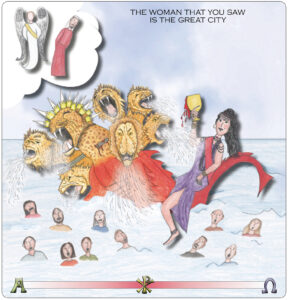 dragon (Satan) mimics God, while in the seventeenth chapter we see definite signs of anti-liturgy, or liturgy set
dragon (Satan) mimics God, while in the seventeenth chapter we see definite signs of anti-liturgy, or liturgy set 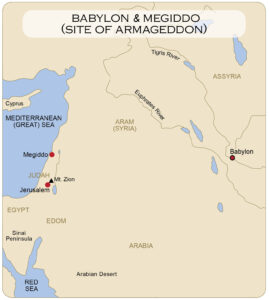 up in opposition to the worship of God. Throughout the Scriptures, idolatry is presented as a terrible sin, and the Bible offers one situation after another in which humanity not only chooses to ignore God but also makes the decision to worship something other than God. This often is humanity itself, but there are other false gods as well. In the book of Revelation, we see false worship practices idolizing Satan and the extensions of his power and rule. The harlot’s role in the seventeenth chapter of the book of Revelation is anti-liturgical—she leads humanity in false worship. Click on the image (above right) to enlarge Turning to God’s Word co-founder Tami Palladino’s illustration, which appears on page 111 of The Revelation of Jesus Christ: The Faithful Witness. The map, which shows the location of Megiddo (associated with Armageddon in the book of Revelation). is on page 113 and elsewhere in the study book; the image can be enlarged by clicking on it. Learn more about Megiddo in Lesson 26 Josiah Institutes Reforms in Thus
up in opposition to the worship of God. Throughout the Scriptures, idolatry is presented as a terrible sin, and the Bible offers one situation after another in which humanity not only chooses to ignore God but also makes the decision to worship something other than God. This often is humanity itself, but there are other false gods as well. In the book of Revelation, we see false worship practices idolizing Satan and the extensions of his power and rule. The harlot’s role in the seventeenth chapter of the book of Revelation is anti-liturgical—she leads humanity in false worship. Click on the image (above right) to enlarge Turning to God’s Word co-founder Tami Palladino’s illustration, which appears on page 111 of The Revelation of Jesus Christ: The Faithful Witness. The map, which shows the location of Megiddo (associated with Armageddon in the book of Revelation). is on page 113 and elsewhere in the study book; the image can be enlarged by clicking on it. Learn more about Megiddo in Lesson 26 Josiah Institutes Reforms in Thus  Says the LORD: God Speaks Through His Servants the Prophets: Volume I: A Kingdom Divided, the first of two volumes in our study of the biblical prophets.
Says the LORD: God Speaks Through His Servants the Prophets: Volume I: A Kingdom Divided, the first of two volumes in our study of the biblical prophets.
 what does this harlot represent? (01:24:17)
what does this harlot represent? (01:24:17)
In the seventeenth chapter in the book of Revelation, the author introduces a new  image in his vision—a counterpart to the archetype of the woman clothed with the sun. As we saw previously, the woman clothed with the sun represents a number of things, one of which is the Church. Now John brings in a parallel image in the mother of harlots, who symbolizes what the worship of evil looks like. In the video for this lesson, Turning to God’s Word author Matthew Phelps urges participants in this study not to get caught up in trying to tie this image to historical people and places.
image in his vision—a counterpart to the archetype of the woman clothed with the sun. As we saw previously, the woman clothed with the sun represents a number of things, one of which is the Church. Now John brings in a parallel image in the mother of harlots, who symbolizes what the worship of evil looks like. In the video for this lesson, Turning to God’s Word author Matthew Phelps urges participants in this study not to get caught up in trying to tie this image to historical people and places.  Looking at the image of the mother of harlots through the lens of prophecy is far more accurate than looking at it as one specific instance in history. While imposing prophecy on history may not always be wrong, it always is limited in terms of time and space. Prophecy itself operates outside of time and space, like God. John’s vision in this section of the book of Revelation is accurate, but his interpretation of it is less so. His interpretation is limited by the confines of his own place in history. The take-away message is a broader view of the realities about God and evil and how we can apply these to our lives to better understand in a general sense what the future holds. The key area of focus in this section is the activity of the Church of the evil in our world.
Looking at the image of the mother of harlots through the lens of prophecy is far more accurate than looking at it as one specific instance in history. While imposing prophecy on history may not always be wrong, it always is limited in terms of time and space. Prophecy itself operates outside of time and space, like God. John’s vision in this section of the book of Revelation is accurate, but his interpretation of it is less so. His interpretation is limited by the confines of his own place in history. The take-away message is a broader view of the realities about God and evil and how we can apply these to our lives to better understand in a general sense what the future holds. The key area of focus in this section is the activity of the Church of the evil in our world.
The Scripture ranges for the videos that accompany this Catholic Bible study match the Scripture ranges for the sets of questions in The Revelation of Jesus Christ: The Faithful Witness. You can follow along with the video overview as Turning to God’s Word author Matthew Phelps discusses Lesson 18, “Mother of Harlots,” on pages 109–114 in the study book.
ex libris—a look at the antichrist & modern culture
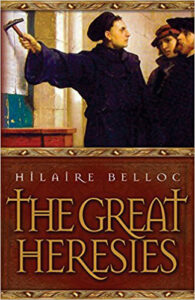 A look at modern culture as antichrist can be found in Hilaire Belloc’s book, The Great Heresies. A Catholic historian and contemporary
A look at modern culture as antichrist can be found in Hilaire Belloc’s book, The Great Heresies. A Catholic historian and contemporary  of G.K. Chesterton, Belloc explains key events in history from the perspective of a Catholic worldview, something frequently absent in other histories. Belloc also endorses the view that there’s no single antichrist, but rather that we’re living in an anti-Christian culture. For more information and to read an excerpt, see ex libris—main bookshelf.
of G.K. Chesterton, Belloc explains key events in history from the perspective of a Catholic worldview, something frequently absent in other histories. Belloc also endorses the view that there’s no single antichrist, but rather that we’re living in an anti-Christian culture. For more information and to read an excerpt, see ex libris—main bookshelf.
what does our Christian faith require of us?
What difference does this make to us as Christians? It’s fairly clear that if we decide Nero—or Adolph Hitler, or Minnie Mouse, or whoever—is the antichrist, we can be properly appalled at his or her horrible actions and be done with it, especially if we follow popular thinking and determine the antichrist is some figure from history. If, however, we decide that a large number of elements in our entire current culture are opposed to Christ, then we’re faced with a very different situation. Our Christian faith requires that we oppose those things that are opposed to God, and fight those things that fight against Christianity.
WHAT DO YOU THINK about battling Satan?
Spiritual battle doesn’t always (or even usually) entail taking up the weapons common in traditional warfare. Our battle is more defensive in nature, along the lines of what Paul writes in his Letter to the Ephesians 6:11–17: “Put on the whole armor of God, that you may be able to stand against the wiles of the devil. For we are not contending against flesh and blood, but against the principalities, against the powers, against the world rulers of this present darkness, against the spiritual hosts of wickedness in the heavenly places. Therefore take the whole armor of God, that you may be able to withstand in the evil day, and having done all, to stand. Stand therefore, having fastened the belt of truth around your waist, and having put on the breastplate of righteousness, and having shod your feet with the equipment of the gospel of peace; besides all these, taking the shield of faith, with which you can quench all the flaming darts of the Evil One. And take the helmet of salvation, and the sword of the Spirit, which is the word of God.”
? From what we know of him, Paul was no wimp. What in his Letter to the Ephesians seems to focus on a defensive strategy?
 ? While Paul claims to be listing armor to be used by Christians, what does he include that also could be considered an offensive weapon?
? While Paul claims to be listing armor to be used by Christians, what does he include that also could be considered an offensive weapon?
? The idea of issuing a personal challenge to Satan carries with it a strong whiff of human pride, which ordinarily would suggest foolishness. Consider whether there are any instances in which it might be advantageous to take an aggressive stance in a battle with evil.
? Although the Scriptures never show Jesus backing away from an encounter with evil, in the Gospels Jesus doesn’t have to go seeking Satan. The Evil One shows up in the course of Jesus’ regular activities while Jesus is concentrating on doing the will of his Father. Where have you encountered evil in your day-to-day activities?
? What have you found to be the best way to fight evil in your life?
? What aids does the Church offer to assist Christians in their battle with evil?
? Consider what evidence might have appeared so far in the apocalyptic vision described in the book of Revelation in which Jesus is shown taking a decidedly aggressive position.
follow the leader
The emphasis in the final book of the New Testament seems to be on following Jesus’ lead. History is full of examples of soldiers with good intentions who charged off following their own private battle plans. Not only were they themselves destroyed, but they frequently endangered an entire army and brought about greater losses than would have occurred had they followed their commanding officer. Obedience to God’s word is critical in the battle against evil. The very weapons Paul lists when writing to the Ephesians denote virtue, against which evil always ultimately is proven powerless.
 sexual immorality—you could look it up in our archives
sexual immorality—you could look it up in our archives
The harlot indicates a problem that’s even more serious than that of loose sexual morals. To learn about the link between sexual immorality and idolatry, you can read Lost in Translation, an online column in which Turning to God’s Word author Matthew Phelps helps readers connect with ideas expressed in the original languages of the Scriptures. New Lost in Translation entries are posted on Mondays, and past entries are archived on our website. Contact us if you’d like to receive Lost in Translation by email every week.
Q&A—a related comment about the Mass readings
A reader in one of our study groups offered the following comment about another New Testament reference to (sexual) immorality, this one in Paul’s First Letter to the Corinthians 6:18 (RSVCE): “Shun immorality. Every other sin which a man commits is outside the body; but the immoral man sins against his own body.” With the exception of using more inclusive language and replacing the word “shun” with the word “avoid,” the NABRE translates the verse almost identically as: “Avoid immorality. Every other sin a person commits is outside the body, but the immoral person sins against his own body.” Both translations fail to specify that the particular type of immorality Paul is writing about is sexual immorality, and this translation decision concerns Msgr. Charles Pope, a pastor in Washington, D.C., and author of a number of posts on the Catholic website “Community in Mission: Creating a Culture of Encounter,” including this post.
 Q: Here is a link to an article about translation I recently read and found interesting. I’ve often been disappointed with some Lectionary choices and translations for Mass. There’s so much in Scripture that’s left out, and the sections of Scripture in brackets shouldn’t be omitted or considered optional when read aloud. So what if they make the reading longer? But no one asked me. Do you have any thoughts about this?
Q: Here is a link to an article about translation I recently read and found interesting. I’ve often been disappointed with some Lectionary choices and translations for Mass. There’s so much in Scripture that’s left out, and the sections of Scripture in brackets shouldn’t be omitted or considered optional when read aloud. So what if they make the reading longer? But no one asked me. Do you have any thoughts about this?
 A—what Matthew says: We refer translation questions to Turning to God’s Word author Matthew Phelps because of his strong language background. Here’s his response: “I’m not sure I feel the need to comment on this linked piece other than to say that I agree with the author 100 percent, and the piece is well articulated. I wouldn’t blame the Lectionary, though, since it’s necessarily tied to the New American Bible Revised Edition (NABRE). I suppose it’s possible that that translation was specifically revised for use in the Lectionary. If that’s the case, then watering down things like this is pretty offensive.”
A—what Matthew says: We refer translation questions to Turning to God’s Word author Matthew Phelps because of his strong language background. Here’s his response: “I’m not sure I feel the need to comment on this linked piece other than to say that I agree with the author 100 percent, and the piece is well articulated. I wouldn’t blame the Lectionary, though, since it’s necessarily tied to the New American Bible Revised Edition (NABRE). I suppose it’s possible that that translation was specifically revised for use in the Lectionary. If that’s the case, then watering down things like this is pretty offensive.”
what’s the relationship between cults & culture?
Although our modern world goes to great pains to separate religion and culture, the seventeenth chapter in the book of Revelation suggests a strong relationship between the two. Learn more about cults and culture by reading “Cultic Practices Related to the Worship of Evil” on page 112 in The Revelation of Jesus Christ: The Faithful Witness. “Sevens & Eights” on page 114 explains more about the confusing idea of the beast that was and is not.
take a closer look at the illustration
If you look closely at Tami Palladino’s illustration of the harlot on page 111 in The Revelation of Jesus Christ: The Faithful Witness, you’ll see  the harlot’s name of mystery on
the harlot’s name of mystery on 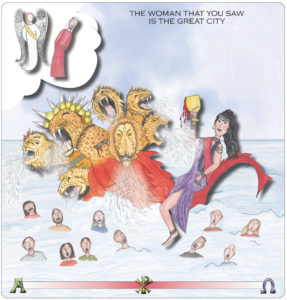 her forehead. As Turning to God’s Word author Matthew Phelps points out in the video for this lesson, the harlot’s name isn’t intended to be the same type of mystery that Sherlock Holmes might be called to solve. You still might find a magnifying glass helpful in reading the harlot’s name in the illustration, however. Because Tami’s original drawings have been minimized to fit in the book, some of the rich detail is difficult to see unless you know to look for it. Clicking on the image at right will enlarge the illustration to fill your computer screen. If you’re attempting this on your phone, you still may need to refer to page 111 in The Revelation of Jesus Christ: The Faithful Witness in order to be able to read the harlot’s name of mystery.
her forehead. As Turning to God’s Word author Matthew Phelps points out in the video for this lesson, the harlot’s name isn’t intended to be the same type of mystery that Sherlock Holmes might be called to solve. You still might find a magnifying glass helpful in reading the harlot’s name in the illustration, however. Because Tami’s original drawings have been minimized to fit in the book, some of the rich detail is difficult to see unless you know to look for it. Clicking on the image at right will enlarge the illustration to fill your computer screen. If you’re attempting this on your phone, you still may need to refer to page 111 in The Revelation of Jesus Christ: The Faithful Witness in order to be able to read the harlot’s name of mystery.
suddenly we encounter a different kind of lull in the action
John is told that he’s going to be shown the judgment of the great harlot, Babylon, but the seventeenth chapter in the book of Revelation indicates this judgment remains in the future. Since we’ve moved out of the trial phase of this book, it’s reasonable to expect to see judgment. The pause that we’ve come to expect to see between the sixth and seventh events in a sequence didn’t occur in the previous chapter of the book of Revelation, but now we seem to be experiencing a different kind of lull. What ideas do you have about why this might be occurring at this point in John’s apocalyptic vision?
the best Catholic commentary about Scripture
 To find out more about how Church teaching is supported by Scripture passages in The Revelation of Jesus Christ: The Faithful Witness, check out the Index of Citations in the Catechism of the Catholic Church. Links to the primary Scripture passages in the lesson (Revised Standard Version Catholic Edition [RSVCE*]) and relevant paragraphs in the Catechism are provided here. Not every passage in the biblical text for this Catholic Bible study is referenced in a Catechism paragraph, however, including the passage in this lesson from the book of Revelation 17:1–18.
To find out more about how Church teaching is supported by Scripture passages in The Revelation of Jesus Christ: The Faithful Witness, check out the Index of Citations in the Catechism of the Catholic Church. Links to the primary Scripture passages in the lesson (Revised Standard Version Catholic Edition [RSVCE*]) and relevant paragraphs in the Catechism are provided here. Not every passage in the biblical text for this Catholic Bible study is referenced in a Catechism paragraph, however, including the passage in this lesson from the book of Revelation 17:1–18.
ways our glossary might prove helpful
In addition to providing extra information about geographical locations, our glossary also points out persons and places mentioned in the biblical text under multiple names or spellings. If you can remember a name but aren’t sure in which lesson it shows up, you can find it in the glossary, which lists every proper noun in the primary biblical text for The Revelation of Jesus Christ: The Faithful Witness.
persons and places mentioned in the biblical text under multiple names or spellings. If you can remember a name but aren’t sure in which lesson it shows up, you can find it in the glossary, which lists every proper noun in the primary biblical text for The Revelation of Jesus Christ: The Faithful Witness.
to learn more, read more Scripture
If you’re having difficulty with a passage of Scripture, it can be helpful to read the  cross references pertaining to it—but looking these up can take time. To make that easier, we’ve compiled the cross references from the Revised Standard Version Second Catholic Edition (RSV2CE)—the translation that we reprint in our study books. That list can be found at the top of every online study page, and it includes links to cross references in the primary biblical text for The Revelation of Jesus Christ: The Faithful Witness.
cross references pertaining to it—but looking these up can take time. To make that easier, we’ve compiled the cross references from the Revised Standard Version Second Catholic Edition (RSV2CE)—the translation that we reprint in our study books. That list can be found at the top of every online study page, and it includes links to cross references in the primary biblical text for The Revelation of Jesus Christ: The Faithful Witness.
review previous lessons
As we progress through the book of Revelation, the images become more complex, increasing the potential for confusion. To help participants  in our study keep track of what’s happening in the Scripture, we’ve prepared a chapter-by-chapter review of key events and images in the book of Revelation. A link can be found at the top of every online study page that accompanies The Revelation of Jesus Christ: The Faithful Witness.
in our study keep track of what’s happening in the Scripture, we’ve prepared a chapter-by-chapter review of key events and images in the book of Revelation. A link can be found at the top of every online study page that accompanies The Revelation of Jesus Christ: The Faithful Witness.
don’t forget about our indexes & extra online material

 If you’re trying to locate information about a specific Scripture passage, you can look it up in the index at the back of the study book or sample lesson. If you want to find a particular commentary, you can look up its title in the topics index. To learn more about another book of the Bible for which there’s a Turning to God’s Word study, visit the online study directories to read the commentaries and watch any accompanying videos. Finally, if you have a question or would like to make a comment about any of our studies, you can use one of the “ask us your question” or “what do you think” buttons to email our authors.
If you’re trying to locate information about a specific Scripture passage, you can look it up in the index at the back of the study book or sample lesson. If you want to find a particular commentary, you can look up its title in the topics index. To learn more about another book of the Bible for which there’s a Turning to God’s Word study, visit the online study directories to read the commentaries and watch any accompanying videos. Finally, if you have a question or would like to make a comment about any of our studies, you can use one of the “ask us your question” or “what do you think” buttons to email our authors.
ex libris—Church documents & books about religious topics
You can find links to magisterial documents referred to in Turning to God’s Word Catholic Bible studies  at ex libris—magisterial documents. This page includes a listing of significant recent encyclicals as well as a number of historical Church documents. Recommended books related to Scripture study can be found at ex libris—main bookshelf.
at ex libris—magisterial documents. This page includes a listing of significant recent encyclicals as well as a number of historical Church documents. Recommended books related to Scripture study can be found at ex libris—main bookshelf.
wondering how to pronounce some of these words?
The following link is to a reading from the New International Version (NIV) Bible. To listen, click on the audio icon above the printed text. Although not taken from the translations used in our study materials, the NIV reading provides an audio guide to pronunciation of words in this lesson’s primary biblical text. A close online version of the translation of the Bible used in Catholic liturgy in the United States as well as an audio guide for daily Mass readings for the current month can be found on the website of the United States Conference of Catholic Bishops (USCCB).
the book of Revelation 17:1–18 (NIV)
 close with Bible-based prayer related to this lesson
close with Bible-based prayer related to this lesson
Many of our Catholic study groups like to conclude their discussions with a prayer based on the scriptural focus of their lesson, and some participants include Scripture-specific prayer in their individual study. If you’re uncomfortable composing your own Bible-based prayers, you can follow our four easy steps. If you prefer, you can use the following short prayer based on this lesson’s text from the book of Revelation.
O God, you created men and women with free will
in order that we could freely choose to love you.
Guide all of our choices and steer us away from the temptation
to be drawn to secular pleasures at the expense of our spiritual well-being.
We ask this in the name of your Son, Jesus Christ,
who established sacraments and true liturgy
that can protect us from evil influences. Amen.
Lesson 19 Fallen, Fallen Is Babylon the Great! the book of Revelation 18:1–24
Lesson 17 Seven Bowls of the Wrath of God, the book of Revelation 16:1–21
you also may like our study of Scripture & the Rosary
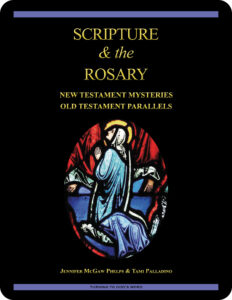 Scripture & the Rosary: New Testament Mysteries, Old Testament Parallels, a 26-lesson Catholic Bible study with an imprimatur, looks at the biblical foundations of the Rosary. The study includes lessons on Pope St. John Paul II’s Rosarium Virginis Mariae (Rosary of the Virgin Mary), the Apostles’ Creed, and the Luminous Mysteries as well as the original 15 Mysteries of the Rosary. Color photographs of stained glass windows depict key scenes in the lives of Jesus and Mary. Free digital lessons rotate throughout the year on our website.
Scripture & the Rosary: New Testament Mysteries, Old Testament Parallels, a 26-lesson Catholic Bible study with an imprimatur, looks at the biblical foundations of the Rosary. The study includes lessons on Pope St. John Paul II’s Rosarium Virginis Mariae (Rosary of the Virgin Mary), the Apostles’ Creed, and the Luminous Mysteries as well as the original 15 Mysteries of the Rosary. Color photographs of stained glass windows depict key scenes in the lives of Jesus and Mary. Free digital lessons rotate throughout the year on our website.
start a Turning to God’s Word Bible study
 Thank you for your interest in The Revelation of Jesus Christ: The Faithful Witness.
Thank you for your interest in The Revelation of Jesus Christ: The Faithful Witness.  Information about beginning a Turning to God’s Word Bible study can be found at start a Bible study. Tami, Matthew, and I are available to answer questions and offer support. Contact us if you’d like to start one of our studies or have your schedule listed with other TtGW study groups on our website. —Jennifer
Information about beginning a Turning to God’s Word Bible study can be found at start a Bible study. Tami, Matthew, and I are available to answer questions and offer support. Contact us if you’d like to start one of our studies or have your schedule listed with other TtGW study groups on our website. —Jennifer
*There are seven deuterocanonical books in the Old Testament—the Books of Tobit, Judith, Wisdom, Sirach, Baruch, and First and Second Maccabees, as well as some passages in the Books of Esther and Daniel. Protestants usually refer to these works as “apocryphal,” a word that means “outside the (Protestant) canon” because they’re excluded from most Protestant Bibles. The word “deuterocanonical” means “second canon”; Catholics use that word to refer to any section of the Catholic Old Testament for which there are no extant, or existing, Hebrew manuscripts. All of the deuterocanonical books appear in the Septuagint, the earliest remaining versions of which date to the 1st century B.C. This Greek translation of the Old Testament was in common use by Jews at the time of Jesus. Learn more by reading How Do Catholic & Protestant Bibles Differ?
Turning to God’s Word printed Bible studies use the 2006 Revised Standard Version Second Catholic Edition (RSV2CE) translation for all Scripture references except those to the Psalms, which are taken from The Abbey Psalms and Canticles, prepared by the Benedictine monks of Conception Abbey and published in 2020 by the United States Conference of Catholic Bishops (USCCB). All Scripture links for the online pages of The Revelation of Jesus Christ: The Faithful Witness are to the 1966 Revised Standard Version Catholic Edition (RSVCE) translation. The New International Version (NIV) audio recordings follow the same chapter and verse numbering as the RSV Catholic translations, but the NIV translation doesn’t include the deuterocanonical books and passages.
The 1966 RSVCE uses archaic pronouns and verb forms such as “thee,” “thou,” “didst” in the Psalms and in direct quotations attributed to God. The 2006 RSV2CE replaces these with more accessible English. The few significant translation changes in the RSV2CE include rendering almah as “virgin” in the Book of Isaiah 7:14 and restoring the term “begotten” in the Gospel According to John 3:16.
Numbering varies for some passages in this Bible study. Turning to God’s Word studies (print and digital) follow the numbering in the Revised Standard Version Catholic translations (RSV2CE and RSVCE). Discrepancies in the New American Bible Revised Edition (NABRE) are noted in the Index of Scripture Citations in the study book and the online sample.
 You can learn more about the Psalms by viewing a sample lesson from the Turning to God’s Word Catholic Bible study Sing a New Psalm: Communicating with God Through the Prayers of the Church—Volume I: Lauds & Vespers. The second part of that study, Sing a New Psalm: Communicating with God Through the Prayers of the Church—Volume II: Vigils, Day Prayer & Compline, is scheduled for publication in 2025. Some verse numbers may vary in different translations of the Psalms.
You can learn more about the Psalms by viewing a sample lesson from the Turning to God’s Word Catholic Bible study Sing a New Psalm: Communicating with God Through the Prayers of the Church—Volume I: Lauds & Vespers. The second part of that study, Sing a New Psalm: Communicating with God Through the Prayers of the Church—Volume II: Vigils, Day Prayer & Compline, is scheduled for publication in 2025. Some verse numbers may vary in different translations of the Psalms.
